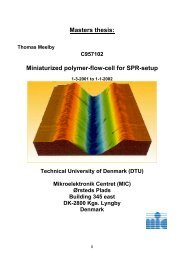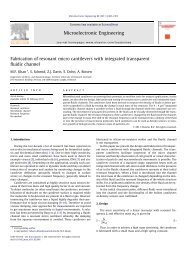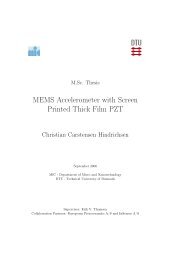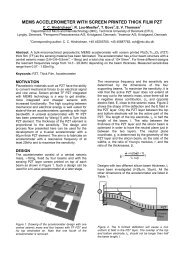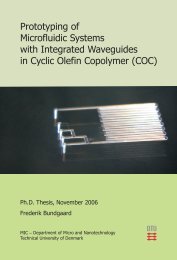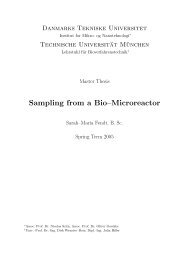Development of a Oxygen Sensor for Marine ... - DTU Nanotech
Development of a Oxygen Sensor for Marine ... - DTU Nanotech
Development of a Oxygen Sensor for Marine ... - DTU Nanotech
Create successful ePaper yourself
Turn your PDF publications into a flip-book with our unique Google optimized e-Paper software.
5.2. BACK-END PROCESSING 47<br />
5.2.2 Ag to Ag/AgCl<br />
Ag has to be turned into AgCl. This can be done in several ways, one <strong>of</strong> the<br />
easier ways[44] however consists <strong>of</strong> using:<br />
1. 0.1 M HCl<br />
2. A flashlight battery.<br />
3. A few centimeters <strong>of</strong> pure silver.<br />
Figure 5.11: Ag turned into Ag/AgCl.<br />
The packaged chip is dipped down into the HCl along with one end <strong>of</strong> the<br />
silver wire. While the battery is connected with the negative terminal to the<br />
silver wire and the positive to the Ag output on the flexprint. Slowly the Ag<br />
electrode will turn a light tan and then a dark brown, at which point it will<br />
have a suitable thick layer <strong>of</strong> AgCl.<br />
5.2.3 Electrolyte and Membrane<br />
Finally the electrolyte and the membrane is added. The material used is<br />
Siloprene from Fluka-Chemie. It consists <strong>of</strong> 3 liquids Siloprene Crosslinking<br />
Agent K-11, Siloprene K 1000 and Hexane. All three liquids are dripped into<br />
the small hole on the device, where the chip is located, by using a syringe<br />
(The amounts used are <strong>of</strong> the order <strong>of</strong> 100:10:1 <strong>for</strong> Siloprene Crosslinking<br />
Agent K-11 : Siloprene K 1000 : Hexane). Finally the sensor is soaked in a<br />
liquid containing a large amount <strong>of</strong> Cl − ions (the time it needs to be soaked<br />
depends on the exact concentration, the higher the concentration is, the less<br />
time it needs. Care should be taken however if a strong acid is used, as it<br />
might damage the membrane) to add the electrolyte. Other membranes have<br />
been used with micro electrode oxygen sensor(such as Nafion[45]). However<br />
this was chosen, due to the recommendation and experiences <strong>of</strong> a pr<strong>of</strong>essor<br />
at MIC.



